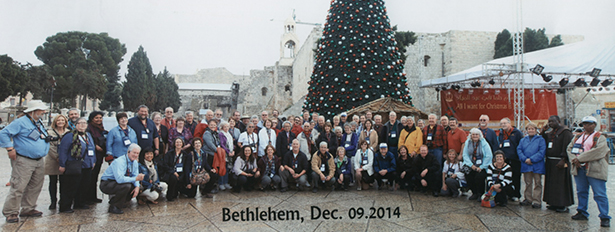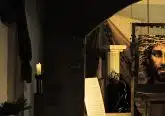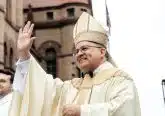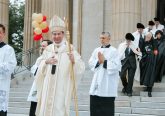Archbishop Schnurr leads pilgrimage to the Holy Land

By Steve Trosley
The Catholic Telegraph
“Seek the face of the Lord.” So declares the Episcopal motto of Archbishop Dennis M. Schnurr, who led a group of 80 pilgrims through the Holy Land in Israel and Jordan on an advent spiritual journey Dec. 1-14.
The pilgrims found the face of the Lord not only in the Biblical sites they visited, but most especially in the faces of the students and teachers of the HOPE project schools they visited in Nazareth and Bethlehem.
Asked if he was spiritually moved by the journey, pilgrim Joseph Re asked, “How could you be Catholic and not be?”
Father Jan Schmidt, pastor of St. Margaret of York Parish and Father Ken Hummel, parochial administrator of Sacred Heart Church in New Carlisle, accompanied the pilgrims on the trip that began with a Mass at St. Margaret of York followed by a bus ride to Chicago O’Hare International Airport. From O’Hare, the pilgrims began a 5,000-plus mile-long journey to Istanbul via Turkish Airlines. From Istanbul, they flew to Tel Aviv, arriving roughly 23 hours after they left St. Margaret of York.
In Tel Aviv, the group met its guides, Franciscan Fathers David Walton and Ben Owusu. Customs and security was smooth and efficient, baggage (or “baggages” as the locals say,) were transferred to a bus for a ride down the coast to the first hotel of the stay at Netanya. In the morning the pilgrims would learn their rooms at the Ramada Hotel overlooked the Mediterranean Sea. During the drive to Netanya, in two separate buses, Father Owusu reminded the pilgrims they were on a spiritual journey, as well as a tour, and led them in prayer. The groups on each bus would begin each morning with prayer and occasionally a hymn led by Anne McGuire, program director at the Maria Stein Shrine. McGuire had assisted in preparing a prayer book for the pilgrimage, which contained Mass prayers, Archbishop Schnurr’s prayer for vocations, a Pilgrim’s Prayer, Prayer for Peace and a selection of hymns.
Father Owusu, a native of Ghana who, with Father Walton, is a member of the Franciscans of the Holy Land and has lived there for almost 20 years also directed the pilgrim’s attention to points of interest, such as a string of Nespresso billboards bearing the image of actor George Clooney sipping the product.
Driver George Khader, a Catholic Arab, weaved skillfully through impossible careening traffic in Haifa and across the winding, climbing and diving roads of the Israeli countryside, delivered the pilgrims safely to Cana, where the married couples in the group renewed their marriage vows. The pilgrims also visited Caesarea and visited Mount Tabor and saw the cave of Elias the prophet. Each stop was matched with the appropriate scripture readings, either from the Old or New Testament.
The spiritual component of the pilgrimage, even to those who did not accompany the group, was always apparent. For example, pilgrim Kathy Re was frequently seen touching one of the almost 30 rosaries she carried to a holy site, rock or stream. Friends and family members had given them to her to carry along the way. Steve Bird and his wife, Rose, took turns taking pictures of each other drawing water into a bottle from Banias Spring near Mount Herman, the source of the Jordan River.
“While they (souvenirs, photos and sacramental) are typically thought of as shallow or materialistic, I believe they also serve an evangelization function to show people back home the life and ministry of Jesus,” said pilgrim Gary Welsh, “to provide a better understanding of the local people and for family and friends to have a small, blessed, religious item to guide them in their faith and prayers.”
In addition to the many holy sites the pilgrims visited, they took part in an extra excursion into the Golan Heights to the Israeli border with Syria. From an overlook, they could see the United Nations peacekeeping troops encampment in addition to Israeli and Syrian military outposts on the plain below. The members of the group munched on apples and cashews being sold by a Druze farmer at the overlook as a UN troop convoy sped by on a nearby road.
The pilgrims visited the Basilica of the Annunciation in Nazareth, where they saw the ruins of the home where Mary lived when she accepted her role in salvation as the mother of Jesus from the angel Gabriel. The pilgrims prayed the Angelus at the site and went to Mass in the Basilica of the Annunciation, where they were joined by students and staff from a HOPE Palestinian partner school there. (See accompanying story.)
After the Mass and before lunch, Archbishop Schnurr, Archdiocesan Superintendent of Catholic Schools Jim Rigg and a few staff members met with the Bishop of Nazareth, the Most Reverend Giancinto-Boulos Marcuzzo, who presented the party with commemorative books on the Holy Land visits of St. John Paul II and Pope Benedict XVI.
In a room surrounded by students and teachers from the school, they briefly discussed the importance of the partnership between the Catholic schools of Cincinnati and the Latin Patriarchate schools in Palestine. Bishop Marcuzzo was impressed with the number of students in the Cincinnati Catholic schools (44,000) and Rigg shared that a number of students had approached him about coming to America to visit.
During the period, the pilgrims stayed at Pilgerhaus, in Tiberias, they also rode a boat on the Sea of Galilee. Archbishop Schnurr pointed out a grassy knoll where St. John Paul II said Mass during the jubilee year (2000), noting it had rained all morning that day, turning the hill into a sea of mud.
Later, after some hymn singing and a reading of the Matthew 14: 22-34, the boat’s captain played the spiritual, “Amen” on the boat’s speaker system – and everyone joined in singing. “I can’t believe I’ve been to a Catholic revival on the Sea of Galilee, “ Archbishop Schnurr said chuckling.
Yala-yala. Welcome to Jordan
The pilgrims met their guides for the Jordanian leg of the journey at the Sheik Hussein border crossing. The buses used in Israel were unloaded and after passing through security, the pilgrims walked across the border into Jordan and reloaded a new pair of buses. The excursion into Jordan was planned to avoid the official weekend in Israel where Friday is a day off for Arabs and Saturday, Jews observe the Sabbath.
Lead guide Emad Ziadat, an Arab from Al Fuheis, a suburb of Amman, introduced himself as a trained archaeologist, father of two, devout Catholic and proud Jordanian. He also introduced the pilgrims to an Arabic phrase – “yala-yala” – which translates into “Let’s go!” He also explained that it was “honorable” in Arab culture – especially among the Bedouins – to be hospitable to strangers. Indeed, wherever the buses went, people waved as they passed by and shop keepers invited weary pilgrims to sit and have a cup of tea, “no need to buy.”
Archbishop Schnurr later noted that during the tour through Jordan, he was “delighted by the friendliness and hospitality of the people.”
Ziadat also introduced us to our driver, Mr. Mohammed, “the second-best bus driver in Jordan. Best driver was killed in a bus accident,” he said, laughing heartily.
The pilgrims then went to Mass in Al Fuheis and were surprised to see Christmas decorations in the commercial area. Ziadat explained that the village was predominantly Catholic. The pilgrims also visited Jerash, a city founded by soldiers of Alexander the Great and visited in Amman the ruins of the Citadel, a fortress more than 5,000 years old. In Jordan, our guide also pointed out the valley where Jacob wrestled the angel and the importance of the Roman Decapolis, 10 cities of which Amman – then Philadelphia – was one.
The next day, the pilgrims visited Bethany Beyond the Jordan where John the Baptist baptized Jesus and pilgrims collected small bottles of muddy water to take home. Some also waded into the small, meandering stream after Archbishop Schnurr led them in a renewal of their baptismal vows. Later the groups went to Mount Nebo for Mass in a Franciscan church and saw where Moses was shown the Promised Land before he died.
After a night in a hotel created from an abandon Arab village built into a hillside, the pilgrims descended into Petra, the ancient caravan crossroads city carved into a canyon of red sandstone. (A site made famous by the 1989 film, “Indiana Jones and the Last Crusade.”) Some walked down the Siq, the narrow gorge that leads to the city proper. Others rode horses or took “carriages” down and back.
Touring the ruins in the canyon, some pilgrims took rides on camels offered by Bedouins. One takeaway from the Jordanian visit was the pride and love the citizens have for their royal family.
Back to Jerusalem
Later, the pilgrims returned to Jerusalem after crossing the border at the Allenby Bridge. They learned it’s more complicated to enter Israel from Jordan than it is to enter Jordan from Israel, but the process was generally smooth and efficient. In Jerusalem, the pilgrims checked into their hotel for the remainder of the trip, the Notre Dame of Jerusalem Center, the Holy See’s international pilgrimage center.
The pontifical institute’s mission best explains the last leg of this pilgrimage of Cincinnati Catholics: “For a Christian, a visit to the Holy Land is an encounter with the living Christ, a chance to walk in his foot steps.
It means accepting the adventure of discovering the living presence of Christ, who awaits each pilgrim in the
different places where he lived, preached, and suffered for our salvation.”
The pilgrims went to Beit Jala in Bethlehem for Mass and visited a second Palestinian Christian school. Again, students of a Latin Patriarchate School sang for the Mass, which was also attended by seminarians from the Patriarchate seminary. After the Mass, the Archbishop and all of the pilgrims received carved olive wood gifts from the curate of Biet Jala, Father (Dr.) Faysal Hijazen. Teachers and students gathered around Archbishop Schnurr for group pictures and he blessed them in the plaza outside the school. (Cover Photo.)
The next stop was Nativity Church where the pilgrims saw the birthplace of Jesus, marked with a silver star, also the site where the manger is said to have been placed. Other stops that day included the Grotto of St. Jerome (where he translated the Bible from Hebrew texts) and the Mile Grotto and Shepherd’s Fields, where shepherds are believed to have received the “tidings of great joy.” The pilgrims also visited the Visitation Church where Mary proclaimed the “Magnificat,” and the Church of St. John where John the Baptist was born.
Patriarch of Jerusalem Beatitude Faud Twal, who presented six members of the Equestrian Order of the Knights of the Holy Sepulcher with pins honoring their Holy Land pilgrimage, also met the pilgrims. He also talked about the school partnership, the need for peace and his concerns about the emigration of Christians from the Holy Land because of the pressure from Islamic fundamentalists. He asked all of the pilgrims to work for and pray for peace in the region.
The pilgrims learned how time and time again, these holy places were conquered and churches protecting them were destroyed, only to be rebuilt time and time again. As pilgrim and Director of Catholic Charities of Southwest Ohio Ted Bergh said: “Even as oppression continues, the land survives. And the rebuilding shows us the eternal nature of this place.
“We should all keep in mind what Jesus asked in Matthew 11: ‘What did you (go out into the wilderness) to see?” Bergh said.
The pilgrims also saw a spectacular view of Jerusalem from the Mount of Olives, with the tombs of thousands spread before the city gate where the Messiah is supposed to enter for the Last Judgment.
“Those of us who will be buried here will be first; the rest of you will have to wait your turn,” Father Owusu joked.
The pilgrims joined to say the Lord’s Prayer in the church that marks where Jesus taught it to His disciples; then they squeezed into the small, round building that covers the stone from where He ascended into heaven and which tradition says, bears His footprint. The pilgrims then descended a steep hill to Gethsemane for Mass at the Church of All Nations and touched the stone, the Rock of Agony, where He suffered before His crucifixion.
The group visited the Wailing Wall or western wall of Solomon’s temple and looked up towards the golden dome of the Dome of the Rock and el Aqsa Mosque, which was not accessible during their visit. In that area, they passed through the Jewish Quarter, a beehive of activity, before returning to Notre Dame.
After entering through St. Stephen’s Gate, the pilgrims, in two groups, saw the Pool of Bethesda, the Chapel of Flagellation and the Arch of “Ecce Homo” where Pontius Pilate sentenced Jesus to scourging and crucifixion. Also they saw the stone pit where the Jews held Jesus after he appeared before the Chief Priests and was judged to have blasphemed. The pilgrims followed the Via Dolorosa, reciting the Stations of the Cross along a busy cobblestone street, filled with merchants and pilgrims from around the world.
The street led to the church of the Holy Sepulcher where pilgrims from Russian and Greek Orthodox groups, Armenians, Abyssinians and Coptics merged to touch the rocks of Golgotha where Jesus died on the cross. After the climb to that place, the group descended to the Tomb of the Risen Savior and entered four at a time into the two chambers of the tomb to touch the place where Jesus’ body was placed after Joseph of Arimathea claimed the body form the Romans. Again, the corresponding passages of the Gospel were read to the group by one of its members.
Later, the group went to Mount Zion to celebrate Mass at Dormition Abbey where Mary breathed her last and to see the Upper Room, place of the last supper. “This is not the room,” Father Owusu said to the group gathered in the open, empty chamber. “But it is the place.” The last site of the day was Gallicantu where Peter denied Jesus as the cock crowed.
Before heading back to the United States, the group spent a day in the Dead Sea region, first visiting the place in Bethany where Lazarus was raised from the dead. Several pilgrims braved the steep and narrow entrance to the tomb, crawling on their hands and knees down into the cave. There is a second, easier entrance, but it is in Muslim-held territory and not open to all visitors. The Mount of Temptation, now crowned by a military outpost and accessible via cable car, loomed over a valley of farms and Arab goat herders.
In Jericho, the pilgrims were allowed some time for shopping at what was soon dubbed the Wal-Mart of Israel, where discounts and specials were announced suddenly and frequently – right up to the time of checkout. (Pilgrims also came to call the many McDonalds’ restaurants, U.S. embassies.)
One busload of pilgrims was treated to fresh fruit when the driver abruptly stopped the bus on a crowded Jericho street, ran to a local market and bought a 40-pound punch of bananas – a crop Israelis are increasingly growing and marketing.
After a quick stop for lunch and a look at the caves at Qumran, where the Dead Sea Scrolls were discovered, the group descended further to the Dead Sea itself, where some braved the primitive changing rooms and showers to take a dip in the salty, mineral-laden waters. Some who did described the water as “greasy” and the buoyant experience as “unnerving.”
At the farewell dinner in Jerusalem that evening, Archbishop Schnurr thanked everyone for his/her participation and especially thanked Father Schmidt, (who was often seen hauling the large case with vestments and sacred vessels and arranging protocols with the guardians of the various churches visited.) He also thanked Director of Stewardship Michael Vanderburgh, the organizer of the pilgrimage and members of his support group, Father Hummel for his assistance at the various Masses, and Anne McGuire for her direction of the liturgies.
Pilgrim David Van Sice summed up the experience for most of the pilgrims when he said the relationships he experienced with the other pilgrims “touched my heart.”
This article originally appeared in the January 2015 print edition of The Catholic Telegraph.













